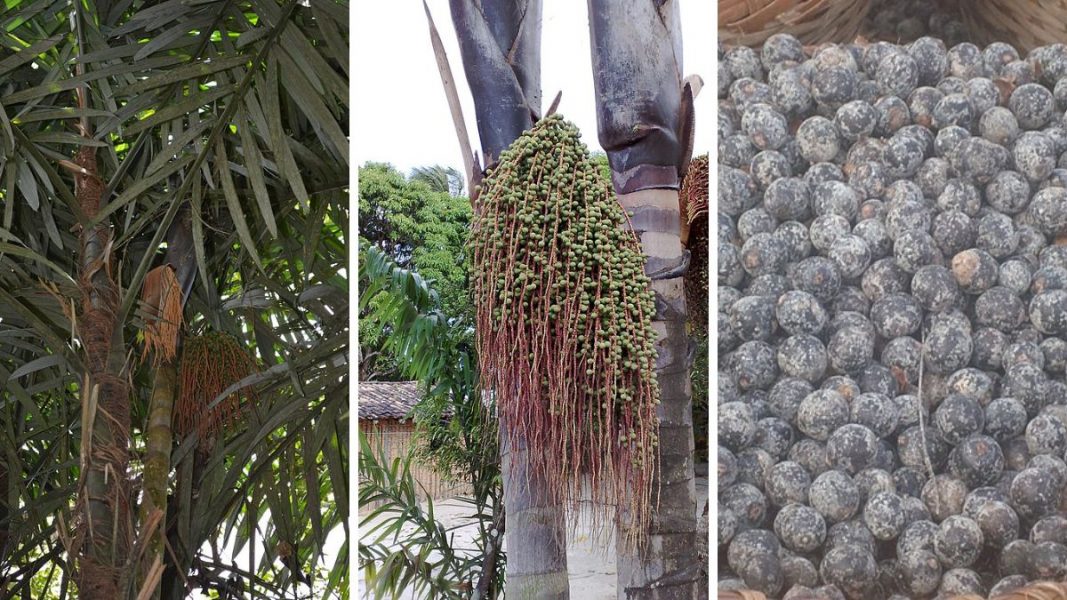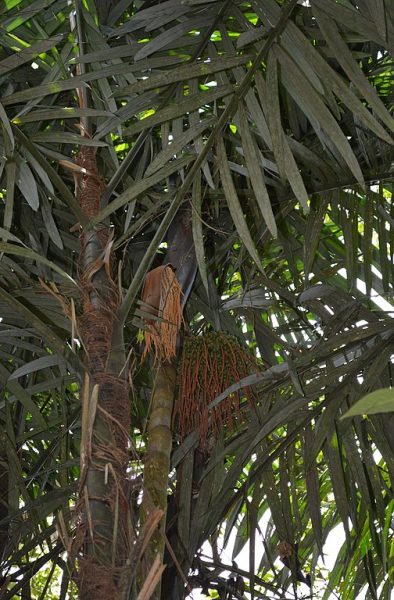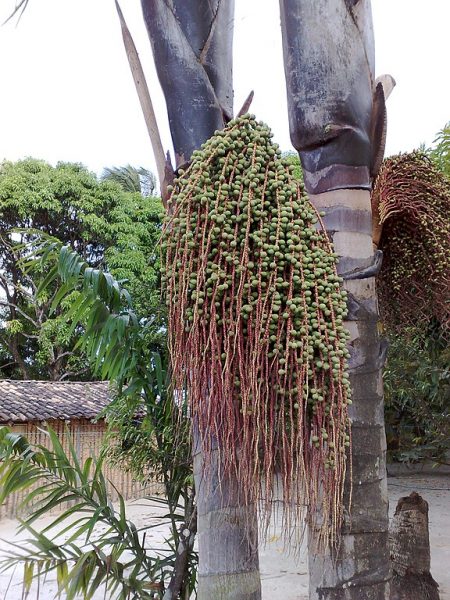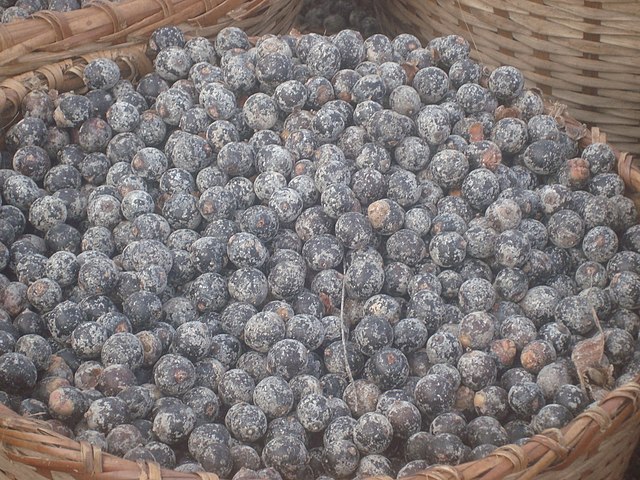
The bacaba (Oenocarpus bacaba Mart.) is a palm tree belonging to the Aracaceae family, which provides a very nutritious fruit and oil with beneficial properties that promote health and beauty.
It is also known as Bacaba açu, Bacaba-de-leque, Bacaba vermelha, Bacabinha and Bacaba verdadeira (Brazil); ungurahui (Peru), camon (French Guiana), cagua (Antilles), baniba, Seje chiquito, Seje finito (Venezuela) and milpesillo, Manoco or Punáma (Colombia),
Origin and distribution
This palm is native to the Amazon and is widely distributed in the Amazon basin up to the Andean foothills in Brazil, Bolivia, Colombia, French Guiana, Guyana, Peru, Suriname and Venezuela; it is also found in the Pacific zone in western Colombia.
Taxonomy
Oenocarpues bacaba belongs to the kingdom Planteae, division Magnoliophyta, class Liliopsida, order Arecales, family Arecaceae, genus Oenocarpus, species Oenocarpus bacaba Mart.1823.

Description of the plant and fruit
It is a solitary palm, with a brown to grayish columnar trunk, which can reach 20-25 meters in height and 12-15 cm in diameter. The crown is formed by about 15 more or less erect leaves, slightly curled in appearance; the sheath is about 1 meter long and is dark green to violet in color, with very fibrous margins. Its fruits are elliptical to globose in shape, up to 2 cm in diameter and violet-blackish in color when ripe; the endocarp is fibrous and the white and creamy flesh resembles Açai (Galeano, 1992) (3).
Difference between Milpesillo and Milpeso
The Milpesillo ( Oenocarpus bacaba Mart.) in its general appearance is very similar to the Milpeso (Oenocarpus bataua Martius) or Seje Palm. However, a notable difference is that Milpesillo has curled or curled leaves, with the pinnae oriented at various angles, while in the Milpesos palm, the pinnae are arranged in the same plane and are pendulous or pendulous. On the other hand, the trunks of the Milpesillos species are generally thinner than those of the seje palm (Galeano, 1992) (3).

Uses of the fruit
The fruit is harvested in the early hours of the morning, because in the hottest hours of the day it is more difficult to climb the palm tree, given the high temperature that heats up the trunk (Carmo do, et al, 2021) (1). Heart of palm is extracted and eaten in salads. Additionally, the fruit can be consumed in the form of porridge, juice or oil. Bacaba oil is obtained from the seeds of this palm tree and is used for medicinal and cosmetic purposes.
This fruit is very similar to the Açai but is browner in color. Its use as a beverage is very popular; “Bacaba wine” is a juice that is prepared in a manner analogous to Açai juice (served iced, mixed with sugar and cassava or tapioca flour). Thus, Bacaba can be an alternative for the final consumer, who, faced with the scarcity or high price of Açai, seeks to substitute it (Nascimento, et al., 2019) (5).

Several studies highlight the potential of Bacaba as a functional ingredient for food and pharmaceutical applications, due to the composition of its fatty acids and the high concentration of phenolic compounds, which provide antioxidant effects and other neuroprotective properties, as well as cholesterol reduction. However, it is essential to develop techniques that guarantee both the maintenance of the nutritional and sensory properties of the products derived from Oenocarpus bacaba Mart. Bacaba pulp obtained by freeze-drying, which generally consists of freezing the product and then removing the ice, applying heat under vacuum conditions (Col de, et al., 2018) (2).
On the other hand, the extraction residues, as well as Bacaba nuts can be used as organic fertilizer, fuel, also in animal rations or in some cases as ingredients of processed products for human consumption (Mambrín and Barrera, 1997) (4).
How is Bacaba “wine” and oil prepared?
Bacaba “Wine”:
The fruits are soaked in warm water for one hour to soften the peel and facilitate the removal of the pulp. The fruit is crushed manually or mechanically and the chocolate-colored juice is strained; it can be served iced or plain, sugar and manioc or tapioca flour are added (Souza de, et al., 1996). Bacaba “wine” is much cheaper than Açai juice, since a liter of Bacaba wine is half the price of the same amount of Açai juice.
Bacaba oil:
Soak the fruits and when they are soft let them rest for three days, then knead the liquid obtained and boil it. Then add cold water and collect the oil accumulated on the surface and return to the fire (Souza de, et al., 1996).
Nutritional value of the fruit
The pulp of the fruit is highly appreciated in the Amazon region, being an important nutritional source of great energetic value in the diet of the local population, with 106, 62 kcal per 100 g, a high concentration of dietary fiber (22.4% of the recommended daily reference value) and lipids or healthy fats (16.5% of the recommended daily intake) (Nascimento, et al., 2019) (5).
Main beneficial health effects of Bacaba
The consumption of Bacaba pulp can provide positive effects to the human organism, contributing to the prevention of some diseases, such as diverticulitis, colon cancer, cardiovascular problems, diabetes, obesity, among others, due to the presence of antioxidant phytochemicals and its high content of fiber that regulates intestinal transit (Nascimento, et al., 2019) (5).
In addition, Bacaba oil has a high content of polyunsaturated fatty acids including Omega 3 and Omega 6, essential for cell growth and brain function, as well as contributing to the reduction of cholesterol and triglycerides, preventing cardiovascular diseases. Likewise, the emollient and moisturizing properties of this oil favor skin care.
References
- Carmo Souza do, C., Henriques Begot, L., De Campos Paraense, V. and Dias de Freitas, A. (2021). Cadeia produtiva da Bacaba (Oenocarpus bacaba Mart) (OENOCARPUS BACABA MART) Barreiras, Almeirim-Pa. Revista Contribuções às Ciências Sociais, 1(1), s/n. Retrieved from https://www.eumed.net/es/revistas/contribuciones-ciencias-sociales/enero-2021/cadeia-produtivabacaba
- Coll de, C. D., et al. (maio, 2018). Centesimal composition of freeze-dried bacaba (Oenocarpus bacaba) pulp. 6th Food Safety Symposium. Desvendando Mitos, Brazil. Retrieved from http://www.schenautomacao.com.br/ssa/envio/files/122_arqnovo.pdf
- Galeano, G. (1992). Studies in the Colombian Amazon. The palms of the Araracuara region. Bogotá: Universidad Nacional de Colombia. Retrieved from http://tropenbos.org
- Mambrín, M.C. and Barrera, D. (1997). Characterization of palm fruit oils from the Amazonian region of Brazil: Fats and Oils, 48(3), 154-158. Retrieved from https://grasasyaceites.revistas.csic.es/index.php/grasasyaceites/article/view/783/795
- Nascimento, R., et al. (2019). Physical-chemical characterization of bacaba pulp and evaluation of the rheological behavior of its suspensions. Revista Brasileira de Tecnologia Agroindustrial, 13(1), 2767-2784. Retrieved from https://www.researchgate.net/publication/336135573_Caracterizacao_fisico-quimica_da_polpa_de_bacaba_e_avaliacao_do_comportamento_reologico_das_suas
- Souza de, A., et al. (1996). Fruit recipes from Amâzonia. Brasilia: Embrapa. Retrieved from https://www.embrapa.br/busca-de-publicacoes/-/publicacao/664664/fruteiras-da-amazonia

Economist (Central University of Venezuela). Full professor and researcher attached to the “Edgar Abreu Olivo” Agrifood Research Center, Universidad de Los Andes. Doctor from the University of La Laguna (Spain). Award “One of the 10 most consulted authors of the Saber ULA university portal” (2005); prize in the III Essay Contest of the Central Bank of Venezuela BCvoz Economico, 2016, with the work “Theobroma cacao: transformation and consumption of the “food of the gods” in Venezuela and the world” (co-authored).
This post is also available in:
![]() Español (Spanish)
Español (Spanish)
